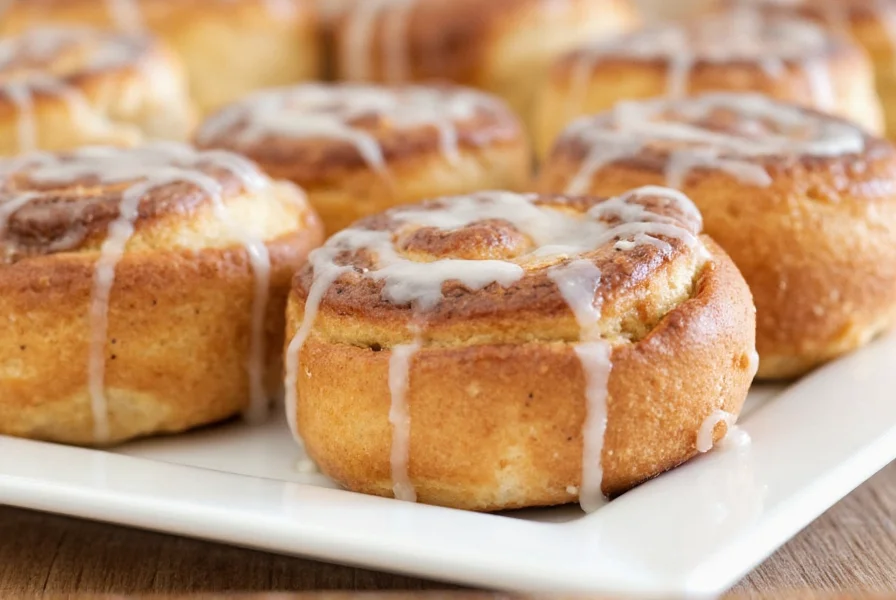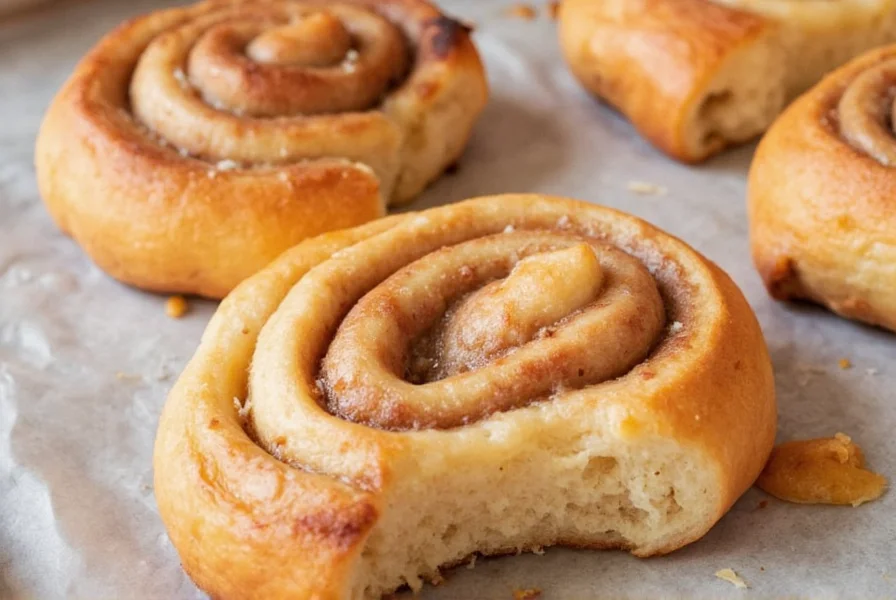If you've ever wondered how to make Cinnabon-style cinnamon rolls at home, you're in the right place. These bakery-famous pastries have captivated taste buds worldwide with their perfect balance of sweet dough, aromatic cinnamon filling, and creamy frosting. The key to authentic results lies in understanding Cinnabon's signature elements: their distinctive spiral pattern, generous filling-to-dough ratio, and that irresistible gooey center.
What Makes Cinnabon Rolls Special
Cinnabon's success isn't accidental—it's the result of carefully calibrated ingredients and technique. Unlike standard cinnamon rolls, Cinnabon uses a higher ratio of filling to dough, creating that signature molten center. Their secret? A specific blend of Korintje cinnamon (sweeter and less bitter than other varieties), a precise dough hydration level, and a particular rolling technique that creates their trademark spiral.
Professional bakers note that Cinnabon's dough contains a touch more sugar than traditional recipes, contributing to both flavor and that distinctive golden-brown crust. The filling incorporates both brown sugar and granulated sugar for complex caramelization during baking.
Authentic Cinnabon-Style Cinnamon Roll Ingredients
This tested recipe delivers the closest approximation to the original while using ingredients readily available to home bakers. All measurements are precise for consistent results.
| Ingredient | Measurement | Professional Tip |
|---|---|---|
| All-purpose flour | 4½ cups (540g) | Spoon and level flour for accuracy |
| Active dry yeast | 2¼ tsp (7g) | Test yeast in warm water first |
| Whole milk, warmed | 1 cup (240ml) | 110°F/43°C is ideal temperature |
| Unsalted butter, softened | ½ cup (113g) | Room temperature for proper incorporation |
| Granulated sugar | ⅓ cup (67g) | Essential for proper browning |
| Egg | 1 large | Room temperature for even mixing |
| Salt | 1½ tsp | Balances the sweetness |
Filling Ingredients
- 1 cup (220g) packed dark brown sugar
- 3 tbsp Korintje cinnamon (not regular cinnamon)
- ½ cup (113g) unsalted butter, melted
- ¼ cup (50g) granulated sugar (for extra caramelization)
Cream Cheese Frosting
- 8 oz (226g) full-fat cream cheese, softened
- ½ cup (113g) unsalted butter, softened
- 2 cups (240g) powdered sugar
- 1 tsp vanilla extract
- Pinch of salt

Step-by-Step Preparation
Dough Preparation
- Activate the yeast: Combine warm milk, 1 tbsp sugar, and yeast in a small bowl. Let sit 5-10 minutes until foamy.
- Mix dry ingredients: Whisk together flour, remaining sugar, and salt in a large bowl.
- Combine wet ingredients: Add yeast mixture, softened butter, and egg to dry ingredients.
- Knead the dough: Mix until a shaggy dough forms, then knead 8-10 minutes by hand or with dough hook until smooth and elastic.
- First rise: Place in greased bowl, cover, and let rise in warm place for 1-1.5 hours until doubled.
Rolling Technique (The Cinnabon Secret)
The distinctive Cinnabon swirl requires a specific rolling method that creates their trademark spiral pattern:
- Roll risen dough into 18x12 inch rectangle on floured surface
- Spread melted butter evenly over dough, leaving ½ inch border
- Mix brown sugar and cinnamon, then sprinkle evenly over buttered dough
- Key technique: Starting from the long side, roll dough tightly toward you, using a bench scraper to help lift the edge
- Once rolled, pinch seam to seal, then use dental floss (not knife) to cut rolls for clean edges
- Place rolls in greased 9x13 inch pan, cover, and let rise 30-45 minutes
Baking Tips for Perfect Results
Achieving that authentic Cinnabon experience at home requires attention to detail:
- Temperature control: Bake at exactly 350°F (175°C)—higher temperatures cause premature browning before the center sets
- Baking time: 22-25 minutes until golden brown (internal temperature should reach 190°F/88°C)
- Cooling: Let rolls cool 5 minutes in pan before frosting—this allows the filling to set slightly
- Frosting application: Spread generously while rolls are still warm for optimal absorption
Storage and Reheating Instructions
To maintain that fresh-from-the-bakery quality:
- Room temperature: Store covered for up to 2 days
- Refrigeration: Keep in airtight container for up to 5 days
- Freezing: Wrap individual rolls tightly and freeze for up to 3 months
- Reheating: Microwave for 10-15 seconds or warm in 300°F oven for 5 minutes—always add extra frosting after reheating
Variations and Customizations
While staying true to the classic, you can personalize your homemade Cinnabon-style rolls:
- Apple Cinnamon: Add ½ cup finely diced apples to the filling
- Pecan Roll: Sprinkle chopped toasted pecans over the filling before rolling
- Sticky Buns: Place pecans and caramel sauce in the bottom of the pan before adding rolls
- Gluten-Free: Substitute with quality gluten-free flour blend (results will vary)
Frequently Asked Questions
What's the secret to getting the perfect Cinnabon swirl pattern?
The key is rolling the dough tightly from the long side while using a bench scraper to help lift the edge as you roll. When cutting, use unflavored dental floss pulled through the roll rather than a knife—this creates clean edges that maintain the spiral shape during baking without compressing the dough.
Can I use regular cinnamon instead of Korintje cinnamon?
While you can substitute regular cinnamon, Korintje (also called Indonesian cinnamon) has a sweeter, more complex flavor with less bitterness than Cassia or Ceylon varieties. This specific cinnamon variety is what gives Cinnabon rolls their distinctive taste. If unavailable, a mix of 2 parts Cassia to 1 part Ceylon cinnamon provides the closest approximation.
Why are my homemade cinnamon rolls dry instead of gooey?
Dry rolls typically result from overbaking, incorrect flour measurement, or insufficient filling. Measure flour properly by spooning into measuring cups and leveling. Bake until internal temperature reaches 190°F (88°C), not just by appearance. Most importantly, use the recommended filling ratio—Cinnabon uses more filling relative to dough than most home recipes, which creates that signature molten center.
How can I make my cinnamon rolls rise properly in cold weather?
In cold environments, create a proofing box by placing the covered dough in your oven with just the light on. The gentle warmth from the bulb creates an ideal 80-85°F (27-29°C) environment. Alternatively, place a bowl of hot water in the oven with the dough. Never use direct heat sources as excessive warmth can kill the yeast.
Can I prepare Cinnabon-style rolls ahead of time?
Yes, for best results assemble the rolls in the pan, cover tightly, and refrigerate overnight. The next morning, remove from refrigerator 30 minutes before baking to take the chill off, then bake as directed. The cold fermentation actually enhances flavor development while providing convenience.











 浙公网安备
33010002000092号
浙公网安备
33010002000092号 浙B2-20120091-4
浙B2-20120091-4